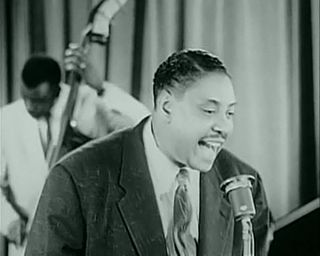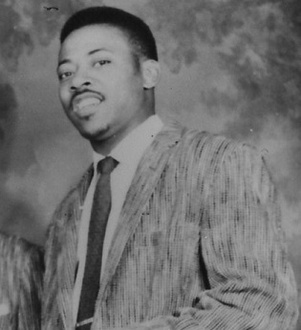Related Research Articles

Rhythm and blues, frequently abbreviated as R&B or R'n'B, is a genre of popular music that originated within the African-American community in the 1940s. The term was originally used by record companies to describe recordings marketed predominantly to African Americans, at a time when "rocking, jazz based music ... [with a] heavy, insistent beat" was starting to become more popular. In the commercial rhythm and blues music typical of the 1950s through the 1970s, the bands usually consisted of a piano, one or two guitars, bass, drums, one or more saxophones, and sometimes background vocalists. R&B lyrical themes often encapsulate the African-American history and experience of pain and the quest for freedom and joy, as well as triumphs and failures in terms of societal racism, oppression, relationships, economics, and aspirations.

"Shake, Rattle and Roll" is a song written in 1954 by Jesse Stone and first recorded that year by Big Joe Turner, whose version ranked No. 127 on the Rolling Stone magazine list of The 500 Greatest Songs of All Time.

The Clovers are an American rhythm and blues/doo-wop vocal group who became one of the biggest selling acts of the 1950s. They had a top 30 US hit in 1959 with the Leiber and Stoller song "Love Potion No. 9".
"I Almost Lost My Mind" is a popular song written by Ivory Joe Hunter and published in 1950. Hunter's recording of the song was a number one hit on the US Billboard R&B singles chart in that year.

"A Fool in Love" is the debut single by Ike & Tina Turner. It was released on Sue Records in 1960. The song is Tina Turner's first release with the stage name "Tina Turner" although she had been singing with Ike Turner and his Kings of Rhythm since 1956. It was the first national hit record for bandleader Ike Turner since the number-one R&B hit "Rocket 88" in 1951, for which he did not receive proper credit.

"Eddie My Love" is a 1956 doo wop song. According to BMI and ASCAP, the song was written by Maxwell Davis (BMI), Aaron Collins, Jr. (ASCAP), and Sam Ling (BMI). Maxwell Davis played sax on the Teen Queens record. Aaron Collins was the brother of the Teen Queens. Sam Ling was an alias of Saul Bihari, co-founder of Modern, RPM, and other labels; Bihari and his brothers regularly attached their names to songwriting credits as a means of getting a cut of the royalties, as was common practice at the time.

"You Know I Love You" is a song written and recorded by B.B. King. Released on RPM Records in 1952, it was King's second No. 1 single on the Billboard R&B chart. King's friend and collaborator Ike Turner played piano on the original recording. The song was included on King's debut album Singin' The Blues in 1957.

This article contains information about albums and singles released by of American musician and bandleader Ike Turner.

Billy Gayles was an American rhythm & blues drummer and vocalist. Gayles was a member of Ike Turner's Kings of Rhythm in the 1950s with whom he recorded for Flair Records and Federal Records as the lead vocalist. Gayles also backed various musicians, including Earl Hooker, Robert Nighthawk, Otis Rush, Albert King, and Richard Arnold "Groove" Holmes.
Billboard Top R&B Records of 1954 is made up of two year-end charts compiled by Billboard magazine ranking the year's top rhythm and blues records based on record sales and juke box plays.
Billboard Top R&B Records of 1955 is made up of three year-end charts compiled by Billboard magazine ranking the year's top rhythm and blues records based on record sales, disc jockey plays, and juke box plays.
Billboard Top R&B Records of 1951 is made up of two year-end charts compiled by Billboard magazine ranking the year's top rhythm and blues records based on record sales and juke box plays.
Billboard Top R&B Records of 1950 is made up of two year-end charts compiled by Billboard magazine ranking the year's top rhythm and blues records based on record sales and juke box plays.
References
- ↑ "1956's Top Rhythm & Blues Records". The Billboard. January 26, 1957. p. 70.